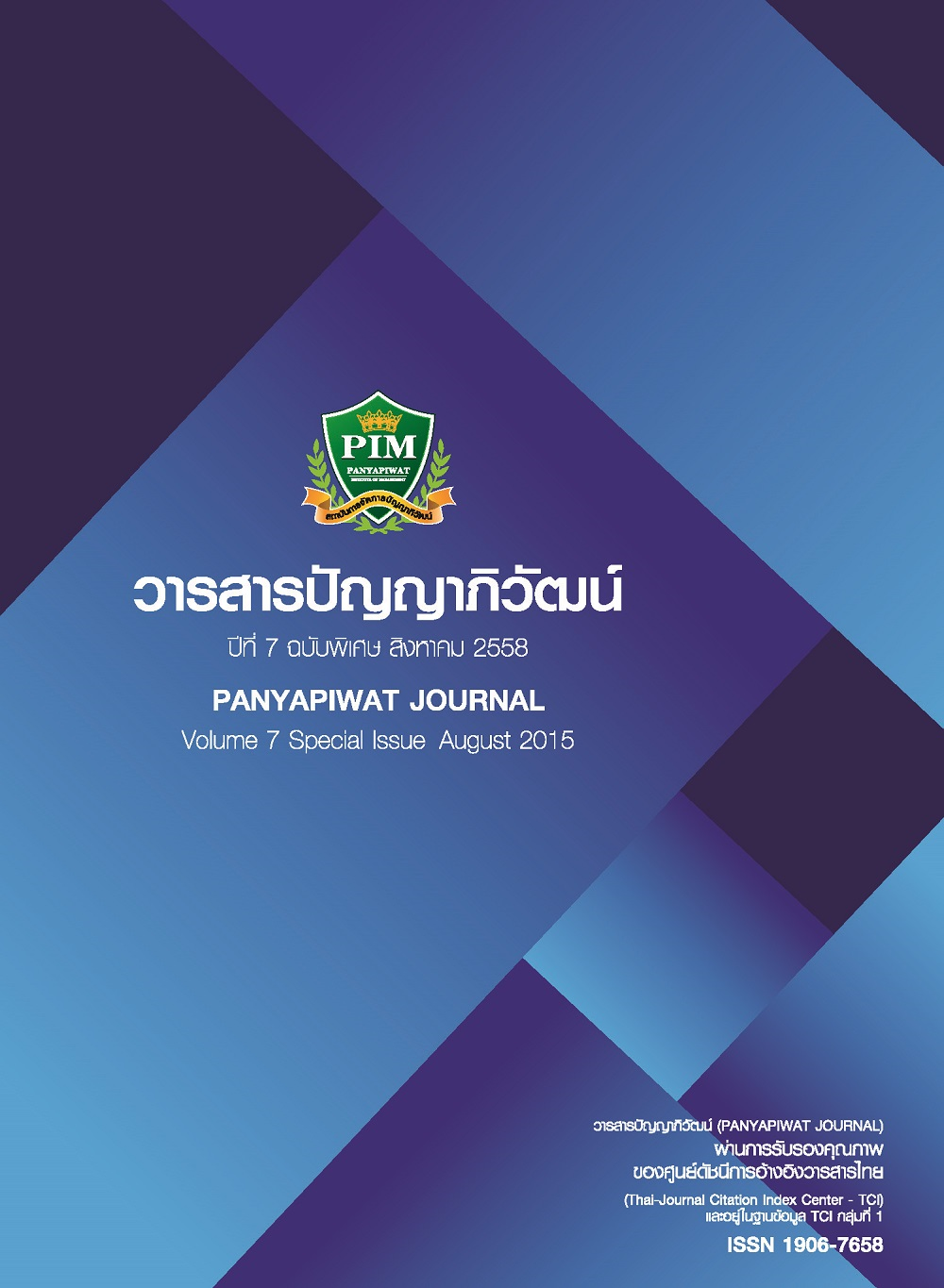ศักยภาพของอินโฟกราฟิก (Infographic) ในการเพิ่มคุณภาพการเรียนรู้
Main Article Content
บทคัดย่อ
บทความนี้นำเสนอเรื่องศักยภาพของอินโฟกราฟิก ซึ่งสามารถประยุกต์ใช้เป็นเครื่องมือจัดการเรียนการสอน เพื่อเพิ่มคุณภาพการเรียนรู้ได้ในสองมิติสำคัญ มิติแรกคือ การใช้อินโฟกราฟิกเป็นเครื่องมือสื่อสารเพื่อสร้างความน่าสนใจ ความเข้าใจ และการจดจำได้ ซึ่งถือเป็นพื้นฐานสำคัญของการสื่อสารที่มีประสิทธิภาพ โดยผลการใช้อินโฟกราฟิกเป็นเครื่องมือสื่อสารจากงานวิจัยของพัชรา วาณิชวศิน พบว่า ร้อยละ 94.99 ของกลุ่มตัวอย่างมีความคิดเห็นว่า อินโฟกราฟิกช่วยเพิ่มความน่าสนใจ ความเข้าใจและการจดจำให้มากยิ่งขึ้น และมิติที่สองคือ การใช้อินโฟกราฟิกเป็นสื่อการเรียนรู้สร้างความพึงพอใจในการเรียนรู้ผ่านการสื่อสารที่มีประสิทธิภาพด้วยความชัดเจนและความเข้าใจ บรรลุวัตถุประสงค์การเรียนรู้ที่ต้องการ โดยผลการใช้อินโฟกราฟิกเป็นสื่อการเรียนรู้จากงานวิจัยฉบับเดียวกันพบว่า อินโฟกราฟฟิกช่วยสร้างความพึงพอใจอยู่ในระดับมากที่สุดด้วยค่าเฉลี่ย 4.82 อย่างไรก็ตาม การประยุกต์ใช้อย่างมีประสิทธิภาพ ควรคำนึงถึงบทบาทสำคัญที่ส่งผลต่อประสิทธิภาพเมื่อใช้เป็นเครื่องมือสื่อสารและสื่อการเรียนรู้ดังนี้ 1) การเพิ่มบทบาทให้กับอินโฟกราฟิกในการสร้างปฏิสัมพันธ์และการมีส่วนร่วมในการเรียนรู้ 2) การปรับบทบาทผู้สอนให้จัดการเรียนการสอนเชิงรุก วางแผนกำหนดเนื้อหา มุ่งเน้นเฉพาะเนื้อหาสำคัญ เลือกวิธีการและออกแบบอินโฟกราฟิกที่ช่วยให้การเรียนรู้บรรลุตามวัตถุประสงค์ 3) การเปลี่ยนบทบาทผู้เรียนให้มีปฏิสัมพันธ์และมีส่วนร่วมในการเรียนรู้อย่างกระตือรือร้น ซึ่งบทบาทเหล่านี้จะช่วยเพิ่มปฏิสัมพันธ์และการมีส่วนร่วมระหว่างผู้สอนและผู้เรียน สร้างบรรยากาศการเรียนรู้ที่ดี รวมทั้งช่วยให้เรียนรู้เนื้อหาที่จำเป็น และแลกเปลี่ยนเรียนรู้จนเกิดการเรียนรู้ที่แท้จริง อันนำไปสู่การเพิ่มคุณภาพการเรียนรู้ในที่สุด
This paper presents the potentials of using infographics in enhancing the quality of learning in two important dimensions. The first dimension is using them as Communication Tool to obtain appeal, comprehension and retention, which is the basic of effective communication. The second dimension is using them as Learning Tool to obtain satisfaction in learning through effective communication with clarity and comprehension to achieve learning objectives. However, using them efficiently, there must be three important roles to play. Firstly, the role of infographics must be increased to encourage interactive and participative learning. Secondly, the role of teachers must be more proactive by planning key contents, defining ways to teach, and designing infographics. Thirdly, the role of learners must be more active in learning. All roles will encourage teachers and learners to be more interactive, have good learning atmosphere, help learners learn key essentials, and exchange learning to have true learning, which will finally lead to the increase of quality of learning.
Article Details
“ข้าพเจ้าและผู้เขียนร่วม (ถ้ามี) ขอรับรองว่า บทความที่เสนอมานี้ยังไม่เคยได้รับการตีพิมพ์และไม่ได้อยู่ระหว่างกระบวนการพิจารณาลงตีพิมพ์ในวารสารหรือแหล่งเผยแพร่อื่นใด ข้าพเจ้าและผู้เขียนร่วมยอมรับหลักเกณฑ์การพิจารณาต้นฉบับ ทั้งยินยอมให้กองบรรณาธิการมีสิทธิ์พิจารณาและตรวจแก้ต้นฉบับได้ตามที่เห็นสมควร พร้อมนี้ขอมอบลิขสิทธิ์บทความที่ได้รับการตีพิมพ์ให้แก่สถาบันการจัดการปัญญาภิวัฒน์หากมีการฟ้องร้องเรื่องการละเมิดลิขสิทธิ์เกี่ยวกับภาพ กราฟ ข้อความส่วนใดส่วนหนึ่งและ/หรือข้อคิดเห็นที่ปรากฏในบทความข้าพเจ้าและผู้เขียนร่วมยินยอมรับผิดชอบแต่เพียงฝ่ายเดียว”
References
กรมวิชาการ. (2545). คู่มือพัฒนาสื่อการเรียนรู้. กรุงเทพฯ: ศูนย์พัฒนาหนังสือ กรมวิชาการ กระทรวงศึกษาธิการ.
นฤมล ถิ่นวิรัตน์. (2555). อิทธิพลของอินโฟกราฟิกต่อการสื่อสารข้อมูลเชิงซ้อน กรณีศึกษาโครงการ “รู้สู้ flood”. ปริญญาศิลปมหาบัณฑิต, มหาวิทยาลัยศิลปากร.
มนตรี แย้มกสิกร. (2550). เกณฑ์ประสิทธิภาพในงานวิจัยและพัฒนาสื่อการสอน: ความแตกต่าง 90/90 Standard และ E1/E2, วารสารศึกษาศาสตร์, 19(1), 1-15.
อาศิรา พนาราม. (2555). Infographic เทรนด์มาแรงในสังคมเครือข่ายนิยม. สืบค้นเมื่อ 20 มีนาคม 2557, จาก http://tcdcconnect.com/content/KnowWhat/1110
Market Plus. (2555). Infographics Era ทำเรื่องยากให้เป็นเรื่องง่าย: How to Create a Successful Infographic. Market Plus, 5(41), 46-54.
Aaron, J. (2013). Infographic Instability: The Pros and Cons of Infographics. Retrieved February 22, 2014, from http://www.steamfeed.com/infographic-instability-pros-cons-infographics/
Alterio, M. (2002). Using storytelling to enhance student learning. The Higher Education Academy.
Avalanche. (2012). 10 Rules that Make an Infographic Cool, Effective and Viral. Retrieved February 22, 2014, from http://www.avalancheinfographics.com/portfolios/10-rules-about-infographic
Baldwin, J. & Roberts, L. (2006). Visual Communication: from Theory to Practice. Lausanne: AVA Publishing.
Blythe-Lord, R. (1991). The Educational Media Design Handbook. USA: Macmillan Publishing Company.
Bromley, K., Irwin-Devitis, L. & Modlo, M. (1995). The Act of Teaching. New York: McGraw-Hill.
Brister, J. (2013). The Effect of Visual Aids on Learning. Retrieved March 22, 2014, from http://www.ehow.co.uk/about_6395799_effect-visual-aids-learning.html
Deshmukh, N. (2013). Advantages and Disadvantages of Visual Communication. Retrieved March 22, 2014, from http://www.buzzle.com/articles/advantages-and-disadvantages-of-visual-communication.html
Edwards, J. (2012). The Benefits of Infographics. Retrieved March 22, 2014, from www.brandjoe.com/page/6
Friedman, V. (2008). Data Visualization and Infographics. Retrieved March 22, 2014, from http://www.smashingmagazine.com/2008/01/14/monday-inspiration-data-visualization-and-infographics/
Finke, T., Manger, S. & Fichtel, S. (2012). Informotion Animated Infographics. Berlin: Gestalten.
Foliaki, V. (2012). Developing Learning Resources: Visual-aids in the Classroom. Retrieved March 22, 2014, from http://repository.usp.ac.fj/5521/1/EDG14__Criteria_for_Visuals_(V._Foliaki).pdf
Gardiner, J. (2002). Using Visual Aids to Promote Learning. Retrieved April 2, 2014, from http://www.cpri.ca/uploads/section000155/files/slp%20-%20visual%20aids%20for%20learning.pdf
Infographics Lab 203. (2012). Infographics Process. Retrieved April 3, 2014, from http://visual.ly/infographics-process
Inspiration Software. (2013). Graphic Organizers: A Review of Scientifically Based Research. Retrieved March 22, 2014, from http://www.inspiration.com/sites/default/files/documents/Detailed-Summary.pdf
Kharbach, M. (2012). Ways to Teach Using Infographics. Retrieved April 3, 2014, from www.educatorstechnology.com/2013/02/ways-to-teach-using-infographics.html
Lester, P. M. (2012). Visual Communication: Images with Messages. (6th ed.). Boston: Cengage Learning.
Lankow, J., Ritchie, J. & Crooks, R. (2012). Infographics: The Power of Visual Storytelling. New York: John Wiley & Sons.
MacQuarrie, A. (2012). Infographics in Education. Retrieved April 3, 2014, from http://www.learningliftoff.com/infographics-education/#.VV043pUcQ6YMc
Candless, D. (2010). The Beauty of Data Visualization. Ted Talk.
Newson, D. & Haynes, J. (2004). Public Relations Writing: Form and Style. California: Wadsworth Publishing.
OSHA Office of Training and Education. (1996). Presenting Effective Presentations with Visual Aids. U.S. Department of Labor.
Patchara Vanichvasin. (2013). Enhancing the Quality of Learning through the Use of Infographics as Visual Communication Tool and Learning Tool. Proceedings of ICQA 2013: The International Conference on QA Culture: Cooperation or Competition.
Smith, J. (2012). 10 Steps to Designing an Amazing Infographic. Retrieved May 22, 2014, from http://www.fastcodesign.com/1670019/10-steps-to-designing-an-amazing-infographic
Smiciklas, M. (2012a). Infographics and the Science of Visual Communication. Retrieved March 20, 2014, from http://www.socialmediaexplorer.com/digital-marketing/infographics-and-the-science-of-visual-communication/
Smiciklas, M. (2012b). The Power of Infographics: Using Pictures to Communicate and Connect with Your Audience. Indiana: Que Publishing.
SpyreStudios. (2012). The Anatomy of an Infographic: 5 Steps to Create a Powerful Visual.Retrieved April 3, 2014, from http://spyrestudios.com/the-anatomy-of-an-infographic-5-steps-to-create-a-powerful-visual/
Tingöy, Ö., Günefler, A., Öngün, E., Demirag, A. & Köroglu, O. (2006). Using Storytelling in Education. Proceedings 4th International Symposium of Interactive Media Design.
United Nation Office on Drugs and Crime (UNODC). (2000). Visual Aids. Retrieved May 22, 2014, from http://.unodc.org/pdf/india/publications/guide_for_Trainers/08_visualaids.pdf
Viegas, F. & Wattenberg, M. (2011). How To Make Data Look Sexy. Retrieved May 22, 2014, from https://datadesign.files.wordpress.com/2012/01/how-to-make-data-look-sexy1.pdf
Visual.ly. (2010). 2010 Email Statistics. Retrieved April 3, 2014, from http://visual.ly/2010-email-statistics
Visual.ly. (2013). Distance Learning: A History of Flexibility. Retrieved March 20, 2014, from http://visual.ly/distance-learning-–-history-flexibility
Wittich, W. A. & Schuller, C. F. (1962). Audio-Visual Materials: Their Nature and Use. (4thed.). New York: Harper & Brothers.
Wikipedia. (2015). Infographic. Retrieved March 20, 2014, from http://en.wikipedia.org/wiki/Infographic
Wikipedia. (2015). Data Visualization. Retrieved March 20, 2014, from http://en.wikipedia.org/wiki/data_visualization
Zisis. (2014). The Pros and Cons of Infographics. Retrieved May 20, 2014, from www.webentrepreneur.ws/pros-cons-infographics/
Translated Thai References
Department of Curriculum and Instruction Development. (2002). Manual of Developing Learning Visual Aids. Bangkok: Book Development Center, Department of Curriculum and Instruction Development, Ministry of Education. [in Thai]
Market Plus. (2012). Infographics Era Make Difficult Content Simple: How to Create a Successful Infographic. Market Plus, 5(41), 46-54. [in Thai]
Panaram, A. (2012). Infographic Hot Trends in Popular Social Network. Retrieved March 20, 2014 , from http://tcdcconnect.com/content/KnowWhat/1110 [in Thai]
Tinwirat, N. (2013). The Influence of Info Graphics on Complex Information: A Case Study of “Roo Soo Flood. Master’s Thesis, Silpakorn University. [in Thai]
Yamkasikorn, M. (2008). How to Use Efficiency Criterion in Media Research and Development: E1/E2 and the 90/90 Standard, Journal of Education, 19(1), 1-15. [in Thai]

